- The recent deleveraging event produced a significant volatility shock, with many market participants assuming the move has fully reset speculative positioning and reduced the likelihood of a second wave of volatility.
- However, realized volatility across long-dated tenors remains near historical lows, and longer-horizon price ranges are still exceptionally compressed. This combination indicates that volatility has not been fully expended and expectations for a renewed expansion remain elevated.
- Around 25% of circulating supply sits within ±10% of spot, leaving a large share of the market sensitive to further price moves. In parallel, sell-side activity has entered a coiling structure, signalling that both profit-taking and loss-taking pressures are becoming exhausted within the current range.
Out of the Frying Pan
On October 10th, the digital asset market experienced its largest deleveraging event on record, resulting in the biggest single-day decline in open interest across the major assets at -$25bn, alongside approximately $19bn in liquidations, as covered in our postmortem of the event, The Great Deleveraging. This flush triggered a significant volatility shock across derivatives markets, marking the strongest systemic reset in positioning on record.
BTC: Open Interest

The liquidation cascades spilled directly into spot markets, producing an extremely disorderly trading environment. BTC recorded an intraday move of 13% and ETH 22%, the 4th and 135th largest such swings of the year, respectively. With open interest now sharply reduced and spot price volatility beginning to cool, many observers have suggested that the volatility event has run its course.
In this report, we assess whether this assumption holds true and explore what current on-chain and pricing conditions suggest for volatility expectations going forward.
Price Swings: BTC vs ETH

Into the Fire
In the aftermath of the flash crash, realized volatility across the short-dated tenors (1-week, 2-week, and 1-month) surged sharply, capturing the intensity of the immediate liquidation-driven impulse, yet notably, remain lower than previous significant corrections across the cycle.
However, this move did not propagate into the longer tenors. The 3-month and 6-month measures saw only modest increases, while the 1-year tenor remained effectively unchanged. Importantly, these longer-dated measures are still sitting near historical lows, indicating that the volatility shock was highly localised and has not yet re-priced longer-term risk.
- 3m Realized Volatility Percentile: 5.1%
- 6m Realized Volatility Percentile: 0.2%
- 1yr Realized Volatility Percentile: 2.0%
Annualized Realized Volatility
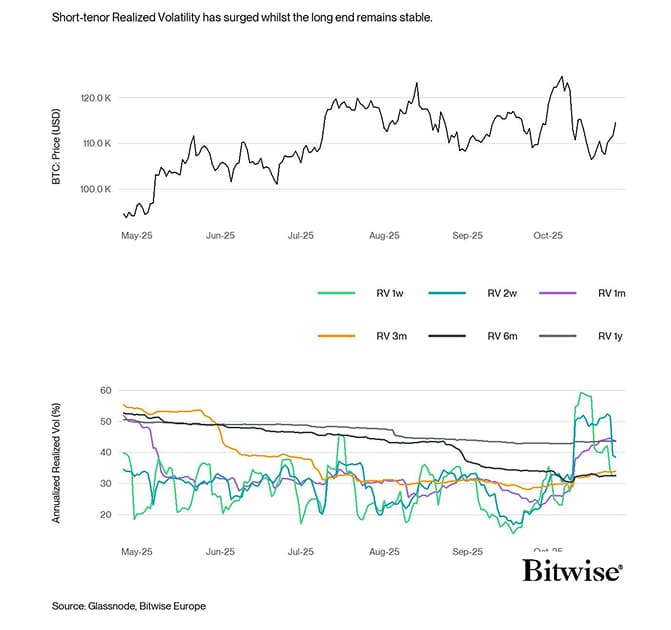
With a notable uptick in realized volatility across the short tenors, we can evaluate how Bitcoin historically behaves following such volatility expansions by comparing its 90-day price performance against the 90-day percentage change in 1-month realized volatility.
The regression analysis shows an R² of 0.146, meaning that around 14.6% of the variance in 90-day price returns can be explained by changes in realized volatility. Historically, when short-dated realized volatility rises, Bitcoin prices move higher 67.31% of the time and decline 32.69% of the time. In effect, nearly 7 out of 10 historical instances of increasing realized volatility have been followed by positive forward returns over the next 90 days. This suggests that rising volatility has tended to occur in alignment with bullish market regimes, rather than as a precursor to downside continuation.
BTC: 90D Return vs 90D Volatility Change
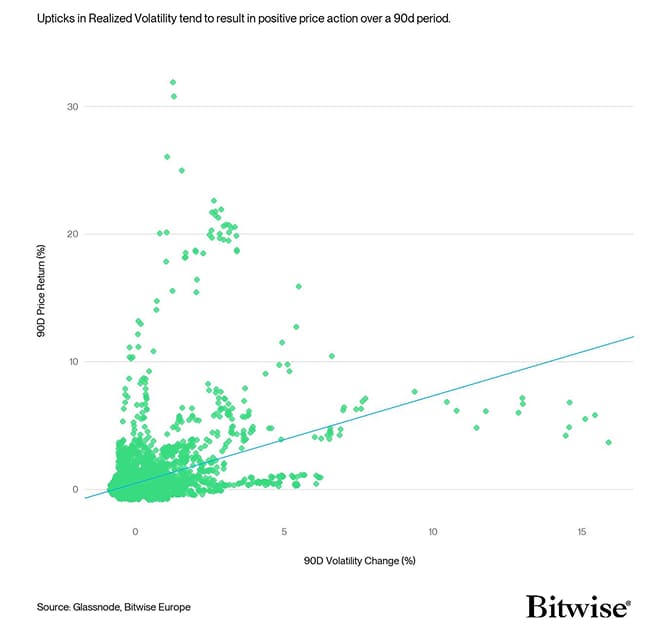
Price action remains the ultimate barometer of supply and demand dynamics, with the current spot price representing the equilibrium between the two forces. By observing the percentage difference between the 30-day high and low, we can quantify how tightly price has compressed and use this as a gauge for forward volatility expectations. Periods of suppressed price action often precede larger directional moves, as compression tends to resolve once a catalyst emerges.
The current 30-day range has expanded relative to recent months to 20.5%, with 1,135 / 5,553 trading days recording a tighter range. This reflects a meaningful pickup in local price action fluctuation, without yet reaching historically extreme conditions.
BTC 30d Price Tightness
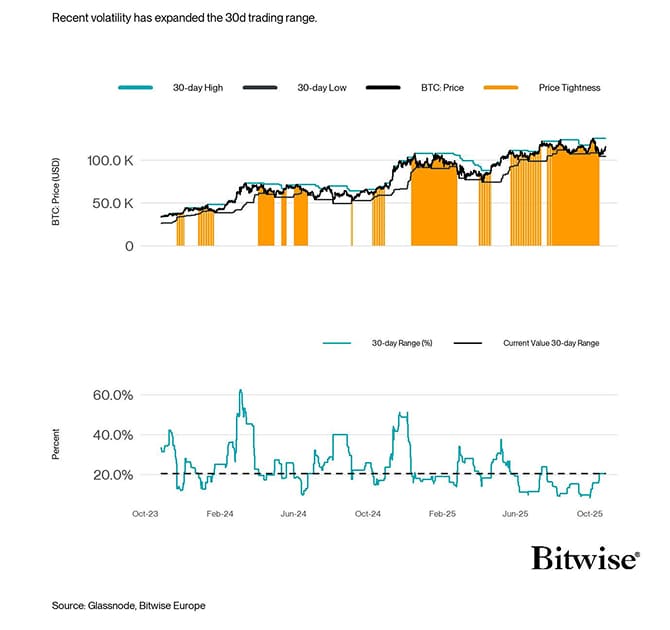
Additionally, by extending the lookback window, we can observe how price compression evolves across multiple timeframes, shifting the perspective from short-lived local moves to longer and more structurally significant events.
The 90-day range is now among the tightest on record, with only 34 out of 5,553 trading days recording a narrower compression, underscoring just how coiled the market has become over a quarterly horizon.
BTC 90d Price Tightness
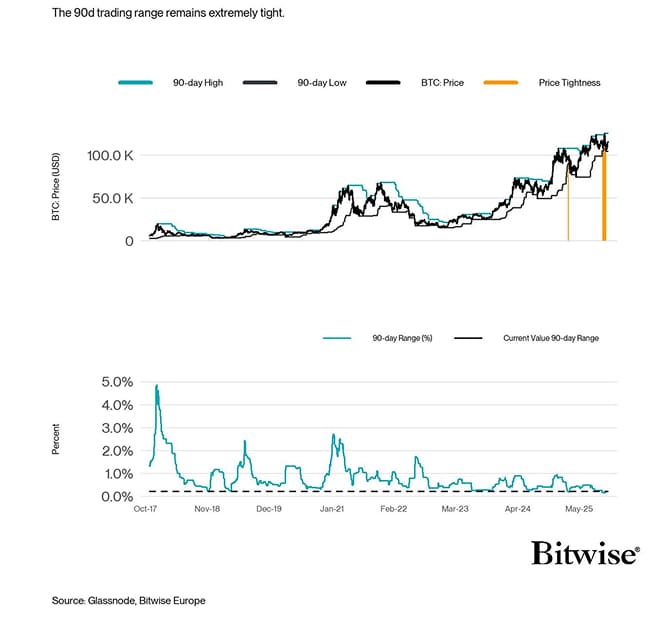
Furthermore, we can assess also the 180-day percentage range to the capture broader market structure. Notably, our 6 months price range is also one of the tightest on record, with a value of 35%, and only 48 / 5553 trading days recording a more constricted range.
Taken together, this creates a coherent picture when viewed alongside realized volatility. The 1-month price range has expanded in response to the recent shock, mirroring the spike in short-dated realized volatility, while the quarterly and semi-annual ranges remain near cycle lows, consistent with the continued suppression in longer-dated tenors.
BTC 180d Price Tightness
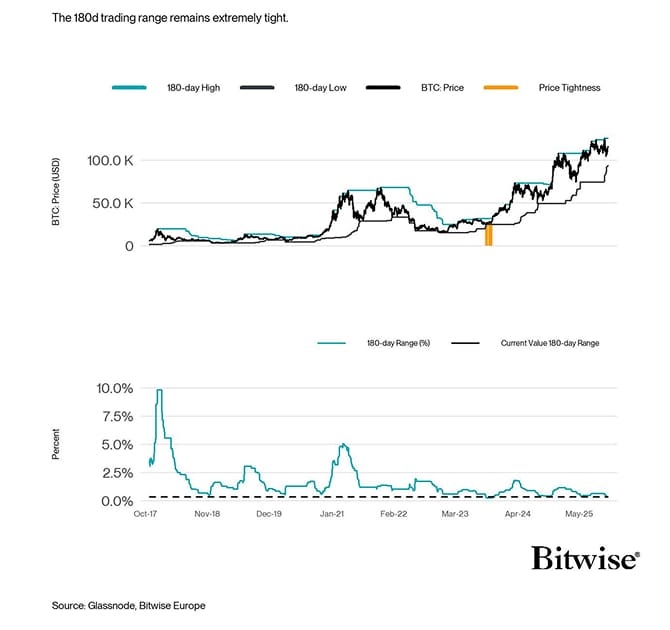
On-Chain Tightening
To complement the price action driven assessment, we can turn to the on-chain domain to assess whether investor positioning and spending activity is consistent with this unspent volatility profile.
The Realized Supply Density metric indicates that market energy remains elevated, even after the sharp volatility event earlier in the month. This metric captures the proportion of supply held within ±10% of the current spot price, illustrating how many coins are positioned close enough to be affected by relatively small price movements. When a large portion of coins cluster around the spot level, even modest price moves can impact a wide group of holders, increasing market sensitivity and sustaining volatile conditions.
At present, roughly 25% of circulating supply resides within this ±10% band, the 126th highest reading since 2015, signalling that a substantial portion of the market remains tightly wound around the current price level. This configuration reflects a market still primed for continued movement and implies that the recent volatility spike has not yet fully resolved.
BTC Volatility Gauge
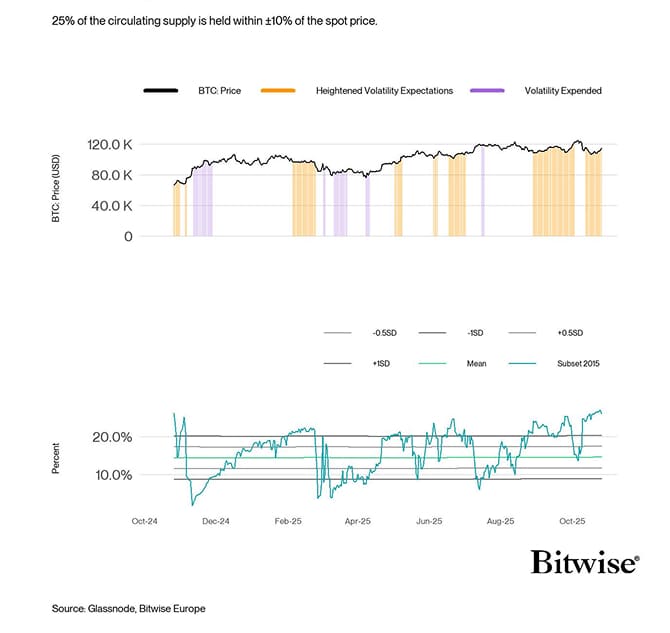
In addition, the Sell-Side Risk Ratio offers a useful lens for evaluating the intensity of profit and loss taking across the current market structure. This metric compares the total volume of profit and loss being realised on-chain against the size of the asset (the Realized Cap), providing insight into how far from their acquisition price investors are transacting.
Elevated values indicate that coins are being spent at significant profit or loss, typically during emotionally charged events, and are usually observed around periods of heavy volatility as the market searches for a new equilibrium. Conversely, low values reflect coins being spent close to break-even, signalling that both profit-taking and loss-taking have diminished and that the market has entered a temporarily balanced state.
In recent weeks, spending activity has risen, led mainly by mature investors realising profits and de-risking into market weakness. However, the amplitude of each successive spending wave across cycle highs has been declining, with both realized profit and loss compressing across the last two years. This creates a coiling structure that suggests macro-scale exhaustion within the current price range, reinforcing the view that a more decisive move will likely be required to re-engage capital participation in either direction.
BTC Sell-Side Risk Ratio

Market Navigation
With volatility expectations elevated, it becomes increasingly important to anchor market analysis around key pricing levels that can help contextualise potential paths forward. Here, we draw on a blend of technical, on-chain, and psychological thresholds that frame the market’s current trading range:
- $100k represents a major psychological level, as well as the structural neckline of the current trading range. A decisive loss of this level would materially increase the risk of further downside.
- The 200-day moving average (~$108k) serves as a widely referenced momentum gauge and often defines the boundary between longer-term trend expansion and contraction.
- The Short-Term Holder cost basis (~$113k) captures the average acquisition price of recent investors and has historically acted as the dividing line between local bullish and bearish regimes. Reclaiming this level is typically a constructive signal for renewed upside participation.
- The $118k level forms the top of the dense supply cluster that spans from $93k to $118k, marking the upper boundary of the core trading range. A sustained breakout above this region would indicate a meaningful display of market strength and likely pave the way for a retest of the all-time high near $126k.
Markets often guide participants to points of maximum indecision, with the recent oscillation of the spot price between the STH-CB and 200-day moving average reflecting this dynamic. While directional forecasting remains inherently difficult in such conditions, the market’s reaction to these key levels will provide valuable signals as volatility begins to resolve.
Key Pricing Levels

Summary and Conclusions
Despite the historic reduction in leverage and the sharp reset in derivatives positioning, the broader market structure continues to point toward elevated forward volatility. Price-based measures show that short-term volatility has already discharged, yet longer-horizon price ranges remain near historical lows, indicating that further volatility may be on the horizon.
On-chain positioning echoes this, with a large share of the circulating supply clustered close to the spot price, leaving the market acutely sensitive to directional moves. Together, these dynamics suggest that the market remains tightly coiled, and the next major move is likely to be decisive for the prevailing market structure.
Important information:
This article does not constitute investment advice, nor does it constitute an offer or solicitation to buy financial products. This article is for general informational purposes only, and there is no explicit or implicit assurance or guarantee regarding the fairness, accuracy, completeness, or correctness of this article or the opinions contained therein. It is advised not to rely on the fairness, accuracy, completeness, or correctness of this article or the opinions contained therein. Please note that this article is neither investment advice nor an offer or solicitation to acquire financial products or cryptocurrencies.
Before investing in crypto ETPs, potentional investors should consider the following:
Potential investors should seek independent advice and consider relevant information contained in the base prospectus and the final terms for the ETPs, especially the risk factors mentioned therein. The invested capital is at risk, and losses up to the amount invested are possible. The product is subject to inherent counterparty risk with respect to the issuer of the ETPs and may incur losses up to a total loss if the issuer fails to fulfill its contractual obligations. The legal structure of ETPs is equivalent to that of a debt security. ETPs are treated like other securities.

